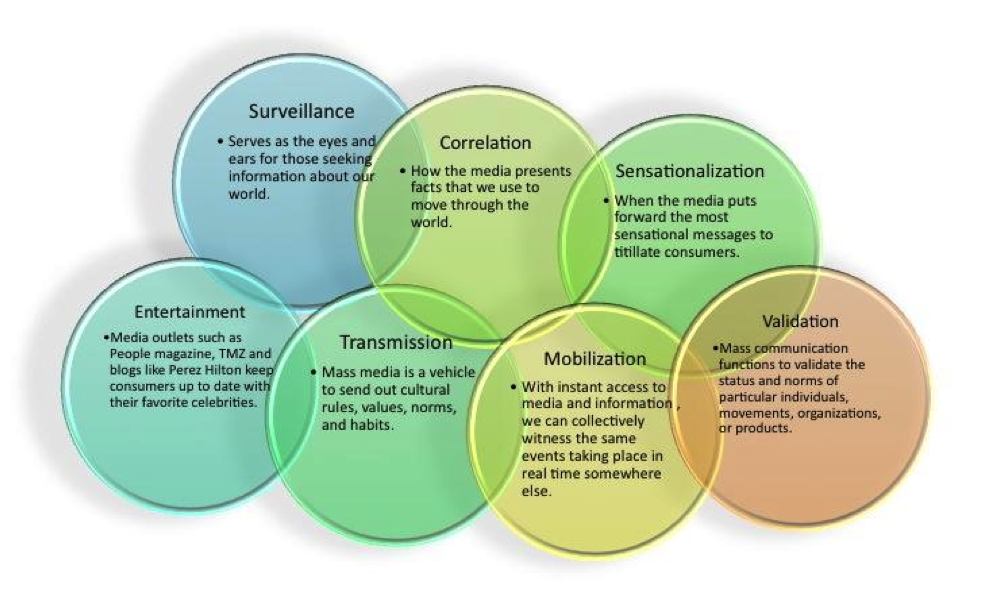Mass communication doesn’t exist for a single purpose. With its evolution, more and more uses have developed and the role it plays in our lives has increased greatly. Wright characterizes seven functions of mass communication that offer insight into its role in our lives.
- Surveillance. The first function of mass communication is to serve as the eyes and ears for those seeking information about the world. The internet, televisions, and newspapers are the main sources for finding out what’s going around you. Society relies on mass communication for news and information about our daily lives, it reports the weather, current issues, the latest celebrity gossip and even start times for games. Do you remember the Boston Marathon Bombing that happened in 2013? How did you hear about it? Thanks to the internet and smart phones instant access to information is at the users fingertips. News apps have made mass communication surveillance instantly accessible by sending notifications to smartphones with the latest news.
- Correlation. Correlation addresses how the media presents facts that we use to move through the world. The information received through mass communication is not objective and without bias. People ironically state “it must be true if it’s on the internet.” However, we don’t think that in generations past people must have without a doubt stated it “has to be true” because it was on the radio. This statement begs the question, how credible are the media? Can we consume media without questioning motive and agenda? Someone selects, arranges, interprets, edits, and critiques the information used in the media. If you ask anyone who works for a major reality TV show if what we see if a fair representation of what really happens, the person would probably tell you “no.”
- Sensationalization. There is an old saying in the news industry “if it bleeds, it leads,” which highlights the idea of Sensationalization. Sensationalization is when the media puts forward the most sensational messages to titillate consumers. Elliot observes, “Media managers think in terms of consumers rather than citizens. Good journalism sells, but unfortunately, bad journalism sells as well. And, bad journalism-stories that simply repeat government claims or that reinforce what the public wants to hear instead of offering independent reporting -is cheaper and easier to produce” (35).
- Entertainment. Media outlets such as People Magazine, TMZ, and entertainment blogs such as Perez Hilton keep us up to date on the daily comings and goings of our favorite celebrities. We use technology to watch sports, go to the movies, play video games, watch YouTube videos, and listen to iPods on a daily basis. Most mass communication simultaneously entertains and informs. People often turn to media during our leisure time to provide an escape from boredom and relief from the predictability of our everyday lives. We rely on media to take us places we could not afford to go or imagine, acquaints us with bits of culture, and make us laugh, think or cry. Entertainment can have the secondary effect of providing companionship and/or catharsis through the media we consume.
- Transmission. Mass media is a vehicle to transmit cultural norms, values, rules, and habits. Consider how you learned about what’s fashionable in clothes or music. Mass media plays a significant role in the socialization process. We look for role models to display appropriate cultural norms, but all too often, not recognizing their inappropriate or stereotypical behavior. Mainstream society starts shopping, dressing, smelling, walking, and talking like the person in the music video, commercial, or movies. Why would soft drink companies pay Kim Kardashian or Taylor Swift millions of dollars to sell their products? Have you ever bought a pair of shoes or changed your hairstyle because of something you encountered in the media? Obviously, culture, age, type of media, and other cultural variables factor into how mass communication influences how we learn and perceive our culture.
- Mobilization. Mass communication functions to mobilize people during times of crisis (McQuail, 1994). Think back to the Boston Marathon Bombing. Regardless of your association to the incident, Americans felt the attack as a nation and people followed the news until they found the perpetrators. With instant access to media and information, we can collectively witness the same events taking place in real time somewhere else, thus mobilizing a large population of people around a particular event. The online community Reddit.com is a key example of the internet’s proactivity. While the FBI was investigating the bombing, the Reddit community was posting witness’s photos and trying to help identify the culprits. People felt they were making a difference.
- Validation. Mass communication functions to validate the status and norms of particular individuals, movements, organizations, or products. The validation of particular people or groups serves to enforce social norms (Lazarsfeld & Merton). If you think about most television dramas and sitcoms, who are the primary characters? What gender and ethnicity are the majority of the stars? What gender and ethnicity are those that play criminals or those considered abnormal? The media validates particular cultural norms while diminishing differences and variations from those norms. A great deal of criticism focuses on how certain groups are promoted, and others marginalized by how they are portrayed in mass media.
Given the power of the various functions of mass communication, we need to be reflective about its presence in our lives (McLuhan & Fiore). We will now turn our attention to the study of mass communication by looking at what mass communication scholars study, and how they study it.
